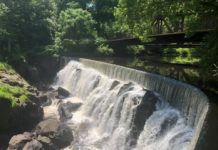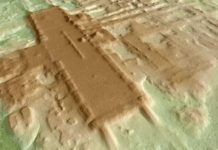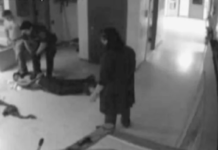Nearly 400 years after the alleged “sale of Manhattan,” some Lenape strive to reawaken their cultural heritage on the islands where their ancestors thrived
A monument in lower Manhattan commemorates the “sale” of Lenape lands to the Dutch. (Colleen Connolly)
When the Dutch arrived in the 17th century in what’s now New York City, their encounters with the indigenous peoples, known as the Lenape, were, at first, mostly amicable, according to historical records. They shared the land and traded guns, beads and wool for beaver furs. As the myth goes, the Dutch even “purchased” Manahatta island from the Lenape in 1626. The transaction, enforced by the eventual building of wall around New Amsterdam, marked the very beginning of the Lenape’s forced mass migration out of their homeland.
The wall, which started showing up on maps in the 1660s, was built to keep out the Native Americans and the British. It eventually became Wall Street, and Manahatta became Manhattan, where part of the Lenape trade route, known as Wickquasgeck, became Brede weg, later Broadway. The Lenape helped shape the geography of modern-day New York City, but other traces of their legacy have all but vanished. In one of the most diverse cities in the United States, there are tellingly few native New Yorkers. Some Lenape today, however, are working to bring their heritage back to the city.
“We love New York. We have a history there before the white man ever showed up, but the Lenape are forgotten because they haven’t had a presence there in decades, centuries,” says Curtis Zunigha, co-director of the Manhattan-based Lenape Center. The center’s mission is to promote Native American arts and humanities, environmental stewardship and Lenape identity.
Zunigha, however, lives in Bartlesville, Oklahoma, where he also works as the director of cultural resources for the Delaware Tribe of Indians. Like many Lenape, he uses the term “Delaware” — the federally recognized name for the Lenape — interchangeably with the group’s own name for itself. None of the three co-directors of the Lenape Center live in New York City, but they decided to base their organization there because of its ties to their ancestry.
The area the Lenape occupied before the Europeans arrived was known to them as Lenapehoking, and it covered roughly the area between New York City and Philadelphia, including all of New Jersey, eastern Pennsylvania and part of the state of Delaware. Like Zunigha, most Lenape today don’t live in New York City or the surrounding area. There are only two federally recognized Delaware tribes in the U.S., and both of them are in Oklahoma, where large groups of the Lenape ended up due to forced migration.
According to Zunigha, his people agreed to move out of Lenapehoking, giving up lands they were promised in treaties, and first migrated to Pennsylvania. From there, they settled in Ohio, then Indiana, then St. Louis, and then elsewhere in Missouri before purchasing a reservation in Kansas in 1830 using funds from previous treaties. After the Civil War, the U.S. government forced the Lenape in Kansas to sell their land so railroad companies could build tracks on it. They then purchased a reservation from the Cherokee in Oklahoma, where they reside today, in Bartlesville and Anadarko. Their kinfolk also reside in Ontario, Canada: the Delaware Nation at Moraviantown and the Munsee Delaware Nation. Smaller bands of Lenape still live in New England and the mid-Atlantic, but most are self-recognized, one exception being the Ramapough Lenape Nation, recognized by the state of New Jersey but not the U.S. government.*
The Lenape who remained in their native lands still have descendants in the area, even if they aren’t part of an official tribe. Margaret Boldeagle of Staten Island is one of them—her grandfather was a Lenape who married an Irish woman.
“In this area you’d be very hard-pressed to find anybody that will tell you that they are full-blood Lenape,” says Boldeagle.
Boldeagle’s family was typical of many Native American families who were pressured to assimilate in order to avoid discrimination. Growing up, she said her grandmother wouldn’t allow her to tell people she was part Native American. When her grandfather gave her some traditional Lenape clothing, her grandmother took it away.
“Back in the day, there was a stigma to being native,” says Boldeagle. “So, a lot of families did not admit to it, would say they’re of another culture.”
As an adult, Boldeagle works to combat some of that stigma. With the help of New York state Sen. Andrew Lanza, Boldeagle resurrected the fight for a national monument to Native Americans at Fort Wadsworth on Staten Island. The land was granted for the monument by an act of Congress in 1911, but it was never built. At that time, department store magnate Rodman Wanamaker came up with the idea to build the National American Indian Memorial, which would feature a 165-foot statue of a Native American — taller than the Statue of Liberty — sitting atop a museum. President William Howard Taft traveled to Staten Island in 1913 to break ground on the project, but the outbreak of World War I in Europe, and the U.S. subsequent involvement, meant the project would soon be abandoned.
Today, two memorials in New York City acknowledge the Lenape, and both contain historical inaccuracies. A monument in Battery Park in lower Manhattan and a bronze plaque in Inwood Hill Park, located far uptown, both commemorate the “sale of Manhattan,” perpetuating a myth that won’t die. Zunigha calls the story an outright “fabrication.”
The Battery Park monument was gifted by the Dutch government to the city of New York in 1926. It depicts a Dutch man and a Native American standing together, but the Native American’s dress is typical of a Plains Native American rather than the Lenape, says David Penney, associate director of museum scholarship at the Smithsonian’s National Museum of the American Indian and curator of a 2020 exhibit on “native New Yorkers.”
The plaque in Inwood Hill Park reads: “According to legend, on this site of the principal Manhattan Indian village, Peter Minuit in 1626 purchased Manhattan island for trinkets and beads then worth about 60 guilders.” The deal was most likely made at Fort Amsterdam, located in lower Manhattan, according to Penney. The Lenape, however, did live in that area, and visitors can still view caves they allegedly used for shelter.
The Lenape likely viewed the “sale” of Manhattan as a deal to share the land, but not to sell it, both Penney and Zunigha say. The Dutch, however, viewed it as a proper sale, and they wanted the indigenous people to leave what they considered as “their” land. Letters and notes from the time document the Dutch frustration with the indigenous who would not leave the land, including one complaint logged from a New Amsterdam council meeting on May 25, 1660, that “the savages would not remove from the land that they had bought” to which the indigenous responded that they had only sold the grass on the land, not the land itself.
The never-built monument on Staten Island would have been the largest and most visible monument to Native Americans in the area, but it would have portrayed them as a “vanishing race,” as Wanamaker viewed them. The Congressional record of the land grant even speaks of the monument as dedicated to “the memory of the North American Indian,” as if they’re already gone.
But while memorials might commemorate the history — or myth — of the Lenape people, their culture remains alive in modern-day tribal communities. In Bartlesville, where Zunigha lives, the Delaware Tribe of Indians hosts summer camps for children to learn Lenape spiritual practices, dances and songs. They have also secured grants to help revitalize the endangered Lenape language, of which there are only a few fluent speakers left in Canada and the United States.
Jim Rementer has studied the Lenape language for more than 50 years. Originally from Pennsylvania, where he first learned about the Lenape, he moved to Oklahoma in the 1960s and learned the language from tribal elders in Bartlesville. Since then, he’s taught classes and helped create the Lenape Talking Dictionary, which includes online lessons with audio. There are no native Lenape language speakers in Oklahoma today, but Rementer says interest in learning the language remains.
“It has a lot of the cultural ties to the Lenape people,” Rementer said. “It at least gives them a basic knowledge of not only the language but also the religious beliefs and so on. And it’s always nice to be able to pray in their native language.”
*Editor’s note, October 8, 2018: This story has been edited to reflect that the Ramapough are recognized by New Jersey, not the state of Delaware.

Zunigha considers himself “barely a partial speaker” of the Lenape language, but he does know how to pray. He admits a lot of the ancestral knowledge has been lost over time, as the Lenape were killed or forced to assimilate or migrate, but he insists the culture has never been lost, partly due to the survival of the language.
“A way is always shown because we’re still here,” Zunigha said. “We have people, including myself, that can pray in our language, conduct ceremonies and remember the ancestors. When we do that we’re blessed with the gift of the creator, with the continuance of our culture for yet another generation. We just try to learn and practice.”
Read more: https://www.smithsonianmag.com/history/true-native-new-yorkers-can-never-truly-reclaim-their-homeland-180970472/#4QQumjtQDPvf89Eo.99
Give the gift of Smithsonian magazine for only $12! http://bit.ly/1cGUiGv
Follow us: @SmithsonianMag on Twitter










